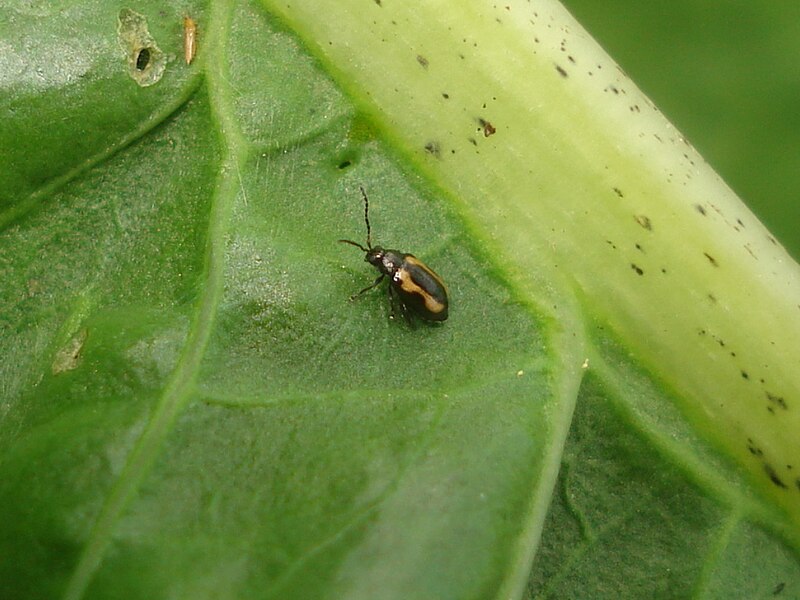
 Plants belonging to the order Brassicales (aka cruciferin plants) produce compounds called glucosinolates (left), or mustard oils, which are responsible for the pungent flavour of mustard, cabbage, and horseradish. These are secondary metabolites that cruciferins use as defense mechanisms against insects and herbivores. When insects, like the striped flea beetle (Phyllotetra striolata), damage plant tissues, the released glucosinolates are brought into contact with an enzyme called myrosinase. This enzyme forms isothiocyanates, which are toxic derivatives of glucosinolates, among other compounds. This adaptation on the part of the plants against herbivory puts a selective pressure on its herbivore, in this case the striped flea beetle, to adapt to this defense. Some insects are able to sequester plant defense compounds and use them for their own protection.
Plants belonging to the order Brassicales (aka cruciferin plants) produce compounds called glucosinolates (left), or mustard oils, which are responsible for the pungent flavour of mustard, cabbage, and horseradish. These are secondary metabolites that cruciferins use as defense mechanisms against insects and herbivores. When insects, like the striped flea beetle (Phyllotetra striolata), damage plant tissues, the released glucosinolates are brought into contact with an enzyme called myrosinase. This enzyme forms isothiocyanates, which are toxic derivatives of glucosinolates, among other compounds. This adaptation on the part of the plants against herbivory puts a selective pressure on its herbivore, in this case the striped flea beetle, to adapt to this defense. Some insects are able to sequester plant defense compounds and use them for their own protection. A group out of the Max Planck Institute in Germany recently reported that not only have flea beetles adapted to the glucosinolates-myrosinase system of cruciferin plants, but they have actually adapted their own system. They are able to sequester intact glucosinolates from their host plant during feeding, and break it down by expressing their own myrosinase enzymes. In fact, these beetles have become so efficient in this system, that they can sequester glucosinolates to levels making up 1.75% of their body weight!
This is the first reported case of a crucifer-feeding beetle with this adaptation to dietary exposure to glucosinolates - typically insects that are able to sequester glucosinolates don't chew on plants, they are sucking insects. The sucking process does not damage the compartments that separate glucosinolates and myrosinase, and so these insects are able to sequester intact glucosinolates, without needing to express myrosinase enzymes to deal with them. The mechanism in which the beetles handle the glucosinolates without autointoxication is not yet clear, but the authors suggest that there is likely some cellular compartmentalization at play that keeps the glucosinolate-myrosinase system separate. It's also possible that these flea beetles use these as a defense mechanism; for example, the cabbage aphid stores and releases glycosinolates as a form of "mustard-oil bomb" when they are attacked.
This study leaves us with a whole host of new questions (as good science does), but it contributes significantly to our knowledge of plant-herbivore co-evolution.
No comments:
Post a Comment